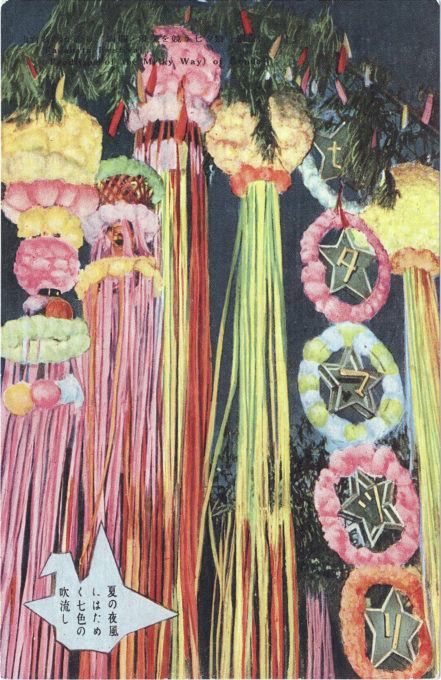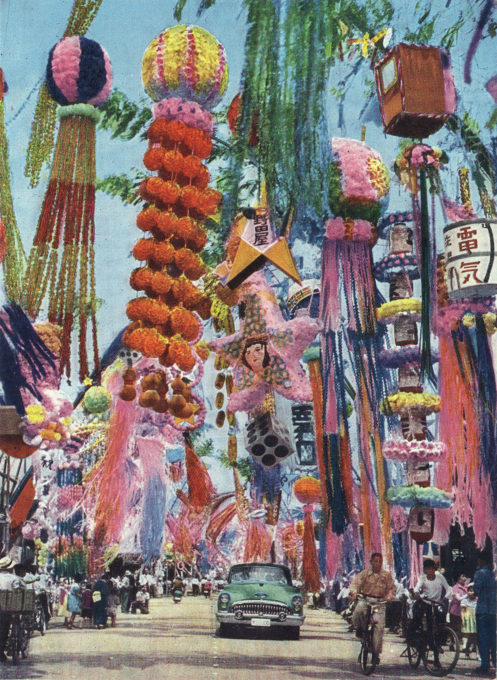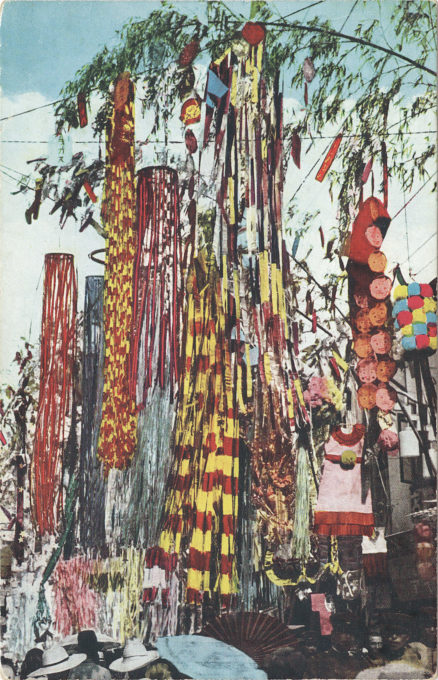
“Tanabata Festival (Tradition of the Milky Way)”, c. 1940. The inset caption reads “The summer night breeze flutters down the seven-colored streamers.” Tanabata-matsuri is observed annually every July 7th.
“Fairylike in its fantasy is its legend: That on the eve of July 7th, Shokujo, or Weaver Princess Star, is supposed to meet Kengyu, or Herdboy Star, on the bank of Amanogawa (‘River of Heaven’), or Milky Way, for their annual tryst. (Verda is the Princess Star; Altair, the Herdboy Star – the pairing of stars known as Lila Aquila.)
“The legend [in] back of this meeting is that the daughter of the celestial king, the celestial princess, a most skillful weaver and the embodiment of industry, while engaged in weaving cloth for the king’s garments, fell in love with a handsome lad, a cow herder, and as a reward for her diligent industry the king allowed them to marry.
“But so much in love were they that the princess gradually neglected her weaving and the herder allowed his cows to stray, which so exasperated the king that he finally separated the couple, forcing them to remain on opposite sides of the Milky Way, and permitting them to approach each other only once a year.
“There is no bridge over the Milky Way and the princess, on her first visit, wept so bitterly at the impossibility of meeting her husband that she roused the sympathy of the kasasagi (magpie) who assured her that a bridge would be contrived for her. This was done, and the magpies with wings spread forming a bridge on which the princess crossed. But, further says the legend, if the eve of July 7th is rainy the magpies will not form the bridge and the celestial lovers must wait another year before meeting.
“The princess, as an accomplished weaver, receives on this day the supplications of those who wish to improve their own weaving, sewing, and their knowledge of the gentle arts: music, poetry, handwriting, etc., of which the princess later became the patron, and farmers ask the herder for bounteous harvests.
“Bamboo trees are set up in front of the houses or before garden shrines and to their branches are hung poems on the love theme of the festival, also papers cut in the shape of kimono (as a tribute to the weaver princess), and to represent cows (for the herder) also threads of five colors: green, red, yellow, white and black (or purple). Melons, peaches, egg-plant and other fruit and vegetables, cakes and sweetmeats are likewise offered.”
– “The Star Festival (‘Hoshi-matsuri’), more popularly known as Tanabata Matsuri”, by Frederic de Garis, We Japanese, Vol. I, Miyanoshita Fujiya Hotel, 1934



